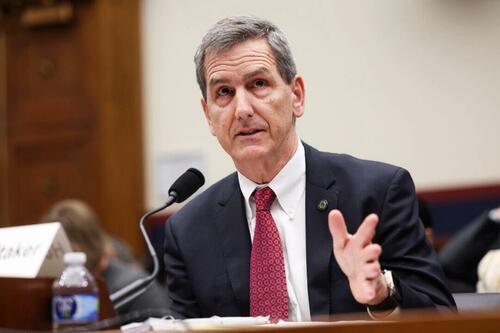
Authored by Aldgra Fredly via The Epoch Times (emphasis ours),
Federal Aviation Administration (FAA) chief Michael Whitaker said on March 19 that his impression from a recent visit to Boeing’s facilities suggests that there are issues within the aerospace giant’s safety culture.

During an interview with NBC Nightly News, Mr. Whitaker said the FAA’s audit and a culture survey of Boeing revealed that the aircraft maker’s “priorities have been on production, and not on safety and quality.”
“So what we really are focused on now is shifting that focus from production to safety and quality,” the FAA administrator told the media outlet.
When asked if certain protocols were not being met regarding how the aircraft manufacturer approached airplane production, Mr. Whitaker said: “Not what you would have expected if safety is the first priority.
“Whenever someone comes into the FAA to brief on their company, the first thing I expect is to talk about safety because we all have to start there.
“If it’s not safe, then the whole system is not working the way it should.”
FAA Audit on Boeing
The FAA initiated a six-week audit on Boeing’s manufacturing processes for the 737 Max jetliner after a panel blew off one of the planes during an Alaska Airlines flight on Jan. 5.
The Alaska Airlines flight was en route to Ontario, California, from Portland, Oregon, when its door plug blew off, forcing the pilots to turn back and make an emergency landing.

The FAA published its 50-page report on Feb. 26, noting that its experts had identified 27 areas in which Boeing’s safety procedures and culture were insufficient.
According to the report, experts observed a “disconnect” between Boeing’s senior management and other members of the organization when it comes to safety culture.
The report also found a “lack of awareness of safety-related metrics at all levels of the organization” and could not find a “consistent and clear” process for employees to report safety concerns.
“The procedures and training are complex and in a constant state of change, creating employee confusion, especially among different work sites and employee groups,” the report reads.
Experts also highlighted “hesitation in reporting safety concerns for fear of retaliation,” noting that managers at the plane manufacturer authorized to oversee employee performance evaluations, salary decisions, promotion, and disciplinary actions are also tasked with investigating safety concerns.
The company was given 90 days to develop a comprehensive plan to address “systemic quality-control issues.” Mr. Whitaker has urged Boeing to make “real and profound improvements.”

Stan Deal, CEO of Boeing’s commercial plane division, said in a March 12 update that the “vast majority” of violations found by the FAA involved workers not following Boeing’s approved procedures.
Mr. Deal said Boeing will take remedial steps that include “working with each employee noted with a non-compliance during the audit to ensure they fully understand the work instructions and procedures.”
The company will also add weekly compliance checks for all work teams in the Renton, Washington, factory, where Max jets are assembled, he said.
“We will assess our status in the factory and, if needed, put mitigation plans in place. We will not hesitate in stopping a production line or keeping an airplane in position,” Mr. Deal stated.
The Alaska Airlines mishap is not the only recent incident to cause concern. On March 7, a United Airlines Boeing 777-200ER plane lost a wheel shortly after takeoff from San Francisco International Airport. On Jan. 20, a Boeing 757 jet operated by Delta Air Lines lost its nose wheel while preparing for takeoff in Atlanta.
Katabella Roberts and The Associated Press contributed to this report.
Authored by Aldgra Fredly via The Epoch Times (emphasis ours),
Federal Aviation Administration (FAA) chief Michael Whitaker said on March 19 that his impression from a recent visit to Boeing’s facilities suggests that there are issues within the aerospace giant’s safety culture.

During an interview with NBC Nightly News, Mr. Whitaker said the FAA’s audit and a culture survey of Boeing revealed that the aircraft maker’s “priorities have been on production, and not on safety and quality.”
“So what we really are focused on now is shifting that focus from production to safety and quality,” the FAA administrator told the media outlet.
When asked if certain protocols were not being met regarding how the aircraft manufacturer approached airplane production, Mr. Whitaker said: “Not what you would have expected if safety is the first priority.
“Whenever someone comes into the FAA to brief on their company, the first thing I expect is to talk about safety because we all have to start there.
“If it’s not safe, then the whole system is not working the way it should.”
FAA Audit on Boeing
The FAA initiated a six-week audit on Boeing’s manufacturing processes for the 737 Max jetliner after a panel blew off one of the planes during an Alaska Airlines flight on Jan. 5.
The Alaska Airlines flight was en route to Ontario, California, from Portland, Oregon, when its door plug blew off, forcing the pilots to turn back and make an emergency landing.

The FAA published its 50-page report on Feb. 26, noting that its experts had identified 27 areas in which Boeing’s safety procedures and culture were insufficient.
According to the report, experts observed a “disconnect” between Boeing’s senior management and other members of the organization when it comes to safety culture.
The report also found a “lack of awareness of safety-related metrics at all levels of the organization” and could not find a “consistent and clear” process for employees to report safety concerns.
“The procedures and training are complex and in a constant state of change, creating employee confusion, especially among different work sites and employee groups,” the report reads.
Experts also highlighted “hesitation in reporting safety concerns for fear of retaliation,” noting that managers at the plane manufacturer authorized to oversee employee performance evaluations, salary decisions, promotion, and disciplinary actions are also tasked with investigating safety concerns.
The company was given 90 days to develop a comprehensive plan to address “systemic quality-control issues.” Mr. Whitaker has urged Boeing to make “real and profound improvements.”

Stan Deal, CEO of Boeing’s commercial plane division, said in a March 12 update that the “vast majority” of violations found by the FAA involved workers not following Boeing’s approved procedures.
Mr. Deal said Boeing will take remedial steps that include “working with each employee noted with a non-compliance during the audit to ensure they fully understand the work instructions and procedures.”
The company will also add weekly compliance checks for all work teams in the Renton, Washington, factory, where Max jets are assembled, he said.
“We will assess our status in the factory and, if needed, put mitigation plans in place. We will not hesitate in stopping a production line or keeping an airplane in position,” Mr. Deal stated.
The Alaska Airlines mishap is not the only recent incident to cause concern. On March 7, a United Airlines Boeing 777-200ER plane lost a wheel shortly after takeoff from San Francisco International Airport. On Jan. 20, a Boeing 757 jet operated by Delta Air Lines lost its nose wheel while preparing for takeoff in Atlanta.
Katabella Roberts and The Associated Press contributed to this report.
Loading…





